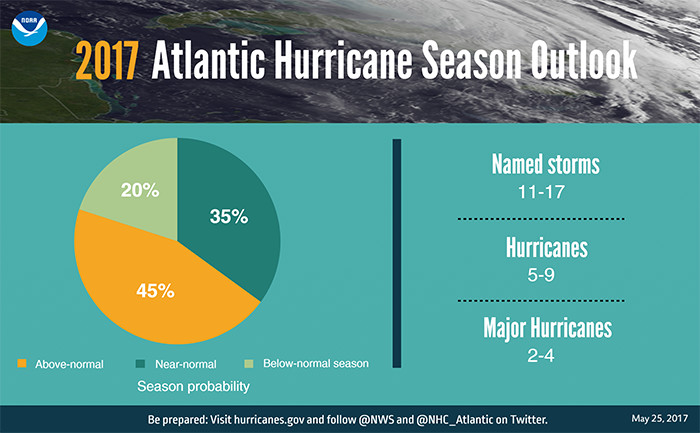NOAA predicts above-normal hurricane season; Atlantic could see up to four major hurricanes, forecasters say
The Atlantic could see another above-normal hurricane season this year, according to Climate Prediction Center forecasters at the National Oceanic and Atmospheric Administration (NOAA).
Forecasters predict a 70 percent likelihood of 11 to 17 named storms with winds of 39 mph or higher. Five to nine of those storms could become hurricanes with winds of 74 miles per hour or higher, they anticipate, with two to four of them becoming Category 3, 4 or 5 hurricanes with winds of 111 miles per hour or higher.
An average season produces 12 named storms of which six become hurricanes, including three major hurricanes.
“As a Florida resident, I am particularly proud of the important work NOAA does in weather forecasting and hurricane prediction,” said U.S. Secretary of Commerce Wilbur Ross. “These forecasts are important for both public safety and business planning, and are a crucial function of the federal government.”
NOAA noted that its forecast includes Tropical Storm Arlene, a rare pre-season storm that formed over the eastern Atlantic in April.
“The outlook reflects our expectation of a weak or non-existent El Nino, near- or above-average sea-surface temperatures across the tropical Atlantic Ocean and Caribbean Sea, and average or weaker-than-average vertical wind shear in that same region,” said Gerry Bell, Ph.D., lead seasonal hurricane forecaster with NOAA’s Climate Prediction Center.
Strong El Ninos and wind shear typically suppress development of Atlantic hurricanes, so the prediction for weak conditions points to more hurricane activity this year. In addition, warmer sea surface temperatures tend to fuel hurricanes as they move across the ocean. However, forecasters say climate models are showing considerable uncertainty, which is reflected in the comparable probabilities for an above-normal and near-normal season.










